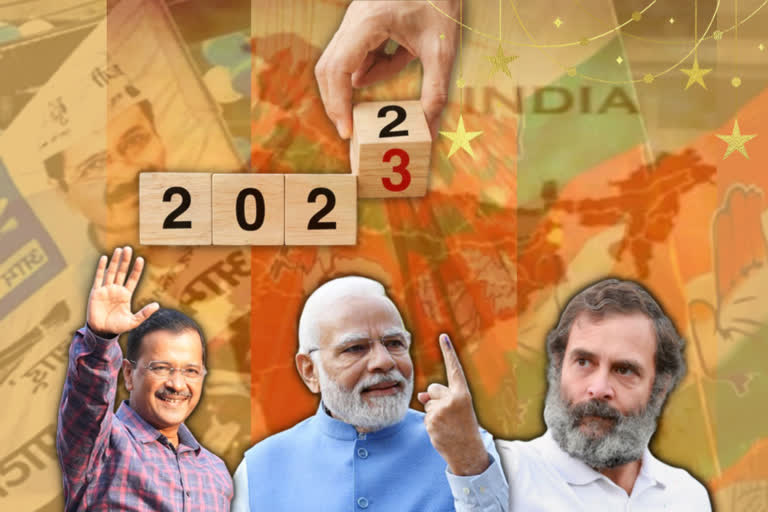Hyderabad:India's political landscape witnessed some major ripples if not a Tsunami in 2022 with Arvind Kejriwal's Aam Aadmi Party (AAP) making its strongest attempt thus far to replace Congress as the main political rival to the Bharatiya Janata Party. As far as the poll calendar was concerned, it was a tight schedule with the country witnessing Rajya Sabha polls, 5 Lok Sabha by-polls, 7 State Legislative Assembly elections, 28 Assembly by-polls, and local body elections in 9 states. The Parliament also elected the country’s President and Vice-president this year.
The BJP fought hard to maintain its momentum in saffronizing the country's political canvass with the highlight of the party's resume being the recent Gujarat win in which "Bhupendra broke Narendra's record" or so was the emphatic victory described by Prime Minister Narendra Modi as he celebrated the result with his partymen.
Congress, meanwhile, continued to struggle as it lost Punjab early in the year to Aam Aadmi Party, though some consolation awaited it at the fag end of the year as it managed to wrestle Himachal Pradesh from BJP.
It was a perfect start for the year for AAP as the party began eyeing other states courtesy of the shot in the arm in Punjab where two former Chief Ministers Parkash Singh Badal and Capt Amarinder Singh along with incumbent CM Charanjit Singh Channi and several other heavyweights of the Punjab politics, immutable for decades, were crushed under the winning wagon of the Aam Aadmi Party.
Punjab was not just a simple victory for Kejriwal's party. In fact, the AAP trounced the 2022 Assembly polls by winning over 90 seats in the 117-seat Punjab Assembly. It is the first time that the party has expanded its political footprint beyond Delhi. Buoyed by the landslide victory, the AAP also made big inroads in Rajya Sabha with five of its candidates getting elected unopposed and taking its total in the Upper House to 10. Kejriwal eyed Modi's turf and thus began AAP gruelling poll campaign in the western state of Gujarat.
Kejriwal even managed to turn the Gujarat elections into a BJP versus AAP narrative as the Congress, the principal opposition party, stuck to a 'silent' campaign. AAP followed the same playbook and deployed the same ecosystem the BJP does during elections -- picking up fights with rivals, launching counterattacks and sending out the desired message to the voters through aggressive poll campaigns, spokespersons and social media -- to build the narrative in its favour.
The party even appointed over a thousand "social media warriors" to drive its poll campaign amid the fierce face-off with the BJP over a range of issues including the alleged corruption in the Delhi excise policy and the alleged misuse of central probe agencies by the Modi dispensation.
As the results came, AAP had managed to breach Gujarat, though not as emphatically as it would have expected. The party won just five seats though it had contested 180 of the total 182 seats. Results showed that over 120-odd AAP candidates could not even save their deposits as they failed to even get one-sixth of the total votes polled.
Key faces of the party in the state including chief minister candidate Isudhan Gadhvi lost to BJP despite Kejriwal and his second-in-command Punjab CM Bhagwant Mann leading several roadshows and rallies in Surat. The AAP won five seats and secured a vote share of 12.92 per cent in the Gujarat assembly elections, as declared by the State Election Commission.
Though he had expected more from Gujarat, Kejriwal thanked the people for helping the AAP "breach the BJP's fortress" and asserted that the party would win the state the next time. "I am thankful to the people of Gujarat for helping us attain the status of national party. Very few parties enjoy the status and now we are one of them. Ours is only a 10-year-old party," the Delhi chief minister said.
Already recognised as a state party in Delhi, Punjab and Goa, the AAP was just one state away from earning the status of national party. To earn the status of a national party, a political outfit needs to be recognised in at least four states. It needs to win at least two seats and 6 per cent of the votes polled in the assembly election to be recognised as a state party.
